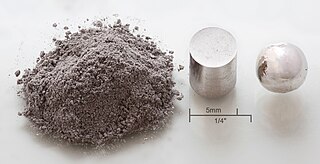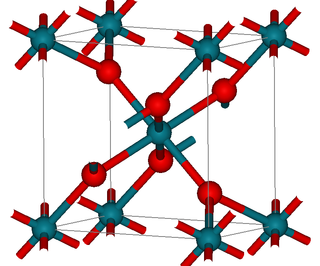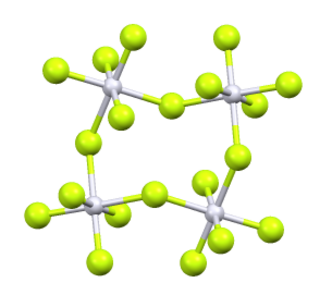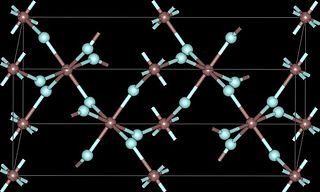Rhodium fluoride may refer to:
- Rhodium(III) fluoride (Rhodium trifluoride), RhF3
- Rhodium(IV) fluoride (Rhodium tetrafluoride), RhF4
- Rhodium(V) fluoride (Rhodium pentafluoride), RhF5
- Rhodium(VI) fluoride (Rhodium hexafluoride), RhF6
Rhodium fluoride may refer to:

Rhodium is a chemical element; it has symbol Rh and atomic number 45. It is a very rare, silvery-white, hard, corrosion-resistant transition metal. It is a noble metal and a member of the platinum group. It has only one naturally occurring isotope, which is 103Rh. Naturally occurring rhodium is usually found as a free metal or as an alloy with similar metals and rarely as a chemical compound in minerals such as bowieite and rhodplumsite. It is one of the rarest and most valuable precious metals.
RH, Rh, rH, or rh may refer to:

Wilkinson's catalyst (chloridotris(triphenylphosphene)rhodium(I)) is a coordination complex of rhodium with the formula [RhCl(PPh3)3], where 'Ph' denotes a phenyl group. It is a red-brown colored solid that is soluble in hydrocarbon solvents such as benzene, and more so in tetrahydrofuran or chlorinated solvents such as dichloromethane. The compound is widely used as a catalyst for hydrogenation of alkenes. It is named after chemist and Nobel laureate Sir Geoffrey Wilkinson, who first popularized its use.

Rhodium(III) chloride refers to inorganic compounds with the formula RhCl3(H2O)n, where n varies from 0 to 3. These are diamagnetic solids featuring octahedral Rh(III) centres. Depending on the value of n, the material is either a dense brown solid or a soluble reddish salt. The soluble trihydrated (n = 3) salt is widely used to prepare compounds used in homogeneous catalysis, notably for the industrial production of acetic acid and hydroformylation.

Hexafluorophosphate is an anion with chemical formula of [PF6]−. It is an octahedral species that imparts no color to its salts. [PF6]− is isoelectronic with sulfur hexafluoride, SF6, and the hexafluorosilicate dianion, [SiF6]2−, and hexafluoroantimonate [SbF6]−. In this anion, phosphorus has a valence of 5. Being poorly nucleophilic, hexafluorophosphate is classified as a non-coordinating anion.

Rhodium(IV) oxide (or rhodium dioxide) is the chemical compound with the formula RhO2.
Rhodium oxide can refer to:

Organorhodium chemistry is the chemistry of organometallic compounds containing a rhodium-carbon chemical bond, and the study of rhodium and rhodium compounds as catalysts in organic reactions.

Rhodocene is a chemical compound with the formula [Rh(C5H5)2]. Each molecule contains an atom of rhodium bound between two planar aromatic systems of five carbon atoms known as cyclopentadienyl rings in a sandwich arrangement. It is an organometallic compound as it has (haptic) covalent rhodium–carbon bonds. The [Rh(C5H5)2] radical is found above 150 °C (302 °F) or when trapped by cooling to liquid nitrogen temperatures (−196 °C [−321 °F]). At room temperature, pairs of these radicals join via their cyclopentadienyl rings to form a dimer, a yellow solid.
Trifluorides are compounds in which one atom or ion has three fluorine atoms or ions associated. Many metals form trifluorides, such as iron, the rare-earth elements, and the metals in the aluminium and scandium columns of the periodic table. Most metal trifluorides are poorly soluble in water except Ferric fluoride and Indium(III) fluoride, but several are soluble in other solvents.

Rhodium hexafluoride, also rhodium(VI) fluoride, (RhF6) is the inorganic compound of rhodium and fluorine. A black volatile solid, it is a highly reactive material, and a rare example of a rhodium(VI) compound. It is one of seventeen known binary hexafluorides.

Xenon hexafluororhodate (XeRhF6) is a deep-red noble gas compound first synthesised in 1963 by Neil Bartlett. It is analogous to xenon hexafluoroplatinate.

Rhodium carbonyl chloride is an organorhodium compound with the formula Rh2Cl2(CO)4. It is a red-brown volatile solid that is soluble in nonpolar organic solvents. It is a precursor to other rhodium carbonyl complexes, some of which are useful in homogeneous catalysis.

Rhodium pentafluoride is an inorganic compound with the formula Rh4F20. It is a red solid. It is prepared by fluorination of rhodium trifluoride at 400 °C.
Rhodium(III) nitrate is a inorganic compound, a salt of rhodium and nitric acid with the formula Rh(NO3)3. This anhydrous complex has been the subject of theoretical analysis but has not been isolated. However, a dihydrate and an aqueous solution are known with similar stoichiometry; they contain various hexacoordinated rhodium(III) aqua and nitrate complexes. A number of other rhodium nitrates have been characterized by X-ray crystallography: Rb4[trans-[Rh(H2O)2(NO3)4][Rh(NO3)6] and Cs2[-[Rh(NO3)5]. Rhodium nitrates are of interest because nuclear wastes, which contain rhodium, are recycled by dissolution in nitric acid.

Rhodium(III) bromide refers to inorganic compounds of the formula RhBr3(H2O)n where n = 0 or approximately three. Both forms are brown solids. The hydrate is soluble in water and lower alcohols. It is used to prepare rhodium bromide complexes. Rhodium bromides are similar to the chlorides, but have attracted little academic or commercial attention.

Rhodium(III) iodide is an inorganic compound with the formula RhI3. It is a black solid.
Rhodium(IV) fluoride is a chemical compound of rhodium and fluorine. It is formed when rhodium(III) bromide reacts with bromine trifluoride. Iridium(IV) fluoride, palladium(IV) fluoride and platinum(IV) fluoride have the same crystal structure.

Ruthenium(III) fluoride is a fluoride of ruthenium, with the chemical formula of RuF3.